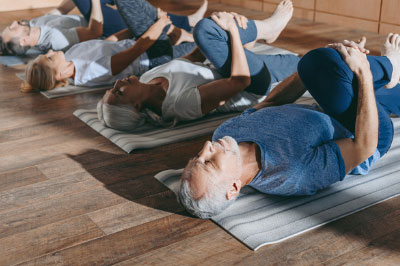Joint pain is never pleasant. Many people living with joint pain find it difficult to manage at times. Pain can cause you to feel years older than you should and make it challenging to find the motivation to get up and stay active. Experiencing joint pain as you grow older is common, but thanks to orthopedic care and advanced treatments, more people are living pain-free than ever before. In fact, over two million hip and knee procedures are performed every year.
There are plenty of measures individuals can take to manage joint pain, and many of them have additional health benefits as well, such as improvements in overall cardiovascular health and mood, as well as decreased stress and increased energy. Staying active can help prevent joint pain from becoming even more acute and can prevent the progression of range-of-motion limitations.
1. Optimize Your Diet
Believe it or not, diet can play an important part in reducing hip and knee pain. Joint pain is common with inflammatory conditions like arthritis and osteoarthritis. Many foods we eat daily are full of ingredients known to increase inflammation and, in some cases, fluid retention.
A diet rich in fruits and vegetables, nuts, fiber, and low in saturated fats helps lower inflammation throughout the body, not just in the joints. Processed items and fast foods may taste good, but they are not safe or healthy for anyone with joint pain.
Everything you eat affects your body. Foods that help support joint health include olives, garlic, walnuts, flax seeds, almonds, pineapples, blueberries, tomatoes, broccoli, salmon, tuna, beans, and whole grains. High inflammatory foods to avoid include sugary beverages, alcohol, excess sodium, and red meat.
2. Get Up and Move
 For many, the first reaction to joint pain is rest. That may seem practical, but it’s actually not very effective at preserving joint function or health. Resting the limb may, in some cases, alleviate the pain, but a lack of movement can quickly make things worse. Without proper movement and conditioning, the muscles, ligaments, and cartilage of the limbs become weaker and less stable.
For many, the first reaction to joint pain is rest. That may seem practical, but it’s actually not very effective at preserving joint function or health. Resting the limb may, in some cases, alleviate the pain, but a lack of movement can quickly make things worse. Without proper movement and conditioning, the muscles, ligaments, and cartilage of the limbs become weaker and less stable.
Movement is essential to maintaining strength, function and range of motion. It’s not necessary to engage in strenuous or high-impact activities when experiencing joint pain. But it is important and extremely beneficial to keep moving the joints, even the painful ones, as much as possible. Stretches, low-impact exercises and light walks are good for alleviating joint pain. Swimming is another extremely popular activity and joint pain therapy for many.
3. Maintain a Healthy Weight
Joints are arguably one of the most misunderstood and underappreciated components of the body. Many don’t realize the overwhelming toll that supporting and moving the body has on their joints until they start to experience stiffness, burning or painful sensations in those areas. They may even struggle with movement.
As joint health starts to decline, usually from age, injuries, or medical concerns, the capacity to support excess weight diminishes. Many joint pain sufferers have unhealthy weights that cause their joints to become unstable. Maintaining a healthy weight is beneficial in alleviating pain in the joints, limbs, and other areas of the body. A healthy weight is less taxing on the joints and overall joint health.
4. Make Lifestyle Adjustments
Movement is one of the most critical factors in preserving joint health and staving off joint problems. For those living with arthritis, osteoarthritis or other painful conditions, taking measures to decrease joint pain includes adjusting daily activities and living habits. Movement is essential for joint health, but it shouldn’t come at the cost of further stress, harm, or increased pain.
Invest in mobility aids to make it easier to perform daily activities with less pain and distress. Many people routinely use canes, crutches, and arthritis support aids. Maintain good posture to support and reduce stress on the joints. Use proper body mechanics when lifting, twisting, and moving the body to prevent joint pain and injury.
5. Get Orthopedic Treatment
Joint pain isn’t always a sign of something serious. But when it becomes severe or persistent enough to disrupt your activities, thoughts and mood, it’s time to find out what’s wrong and how to fix it.
Orthopedic treatments for joint pain don’t stop at standard medications to treat symptoms. Comprehensive orthopedic care includes a range of treatment options, including steroid injections and advanced joint repair and reconstruction options that reduce pain and restore function and mobility.
At the Chicago Center for Orthopedics at Weiss Memorial Hospital, patients come first. Our orthopedic surgeons employ the latest minimally invasive, rapid-recovery surgical techniques. Advanced robotic-assisted technology allows for smaller incisions and less soft tissue injuries that assists in pain reduction and facilitates the return to a more active lifestyle.
For more recommendations from orthopedic specialists on managing joint pain, call (773) 564-7770 to contact the Chicago Center for Orthopedics at Weiss for a consultation with an orthopedic specialist.
